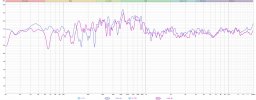Both the app and X send the exact same data and parameters to the AVR at the end of the day because Audyssey has no longer control over the firmware in the units since they sold the license long time ago to SU. No one can change the 12db/oct Butterworth (not Linkwitz to my surprize) high pass filter applied at the XO frequency in these units. Of course, which XO frequency will yield the best response can be calculated accordingly and with X one needs to carry everything over to REW to check this and really know what he's doing while with One this will be done on the go automatically. Your answer was correct btw.
However, the curve also contains a 12db/oct rolloff which isn't directly related to the crossover and is automatically determined during measurements (and is normally the same frequency as the automatically-detected crossover).
What I'm saying is that it might be worth applying that rolloff at the same frequency as your final chosen crossover (ex: 80Hz). Then your EQ filters will apply a 12db/rolloff which, when combined with the built-in 12db/oct rolloff of the crossover filter, would yield 24db/oct rolloff. Theoretically, that's supposed to be better, although I haven't seen anyone test to confirm it. Note that in the editor app this value cannot be changed, only MultEQ-X can change that value, however I estimate that it is somewhere in the ady file and therefore can be changed by your script. With X you can even change the slope to something different than 12db/oct but I'm not sure if there's any good reason to do that normally.
Audyssey also determines a minimum EQ frequency, below which no filters are applied, normally the same as the automatically-determined crossover and rolloff (that is, all 3 values are the same by default). With X those 3 values can be changed independently, and hopefully they can also be changed by externally modifying the ady file.
Last edited:

